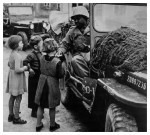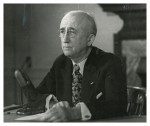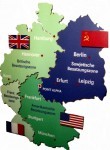
One issue confronting the United States, Britain and Soviet Russia after World War II was how to manage with post-war Germany. Their opinions on this differed, as they had differed with regard to the future of Poland. At the Yalta Conference of 1943, United States president Franklin Roosevelt suggested that Germany be hacked into small pieces, a strategy for limiting its future capacity for war. The Roosevelt plan would abolish the German nation and create several smaller self-governing nations: Hanover, Prussia, Hesse, Saxony and Bavaria. Soviet leader Joseph Stalin, who had more to fear from a resurgent Germany than Roosevelt, enthusiastically agreed. A British report summarised Stalin’s comments on the future of Germany:
“It is far better to break up and scatter the German tribes. Of course, they would want to unite, no matter how much they were split up. They would always want to reunite. In this [reunification] he saw great danger, which would have to be neutralised by various economic measures and, in the long run, by force if necessary. That was the only way to keep the peace. But if we were to make a large combination with Germans in it, trouble was bound to come. We had to see to it that they were kept separate.”
British prime minister Winston Churchill took a different view. Churchill believed a partitioning of Germany was necessary – but not to the extent proposed by Roosevelt. This, Churchill believed, would fill western Europe with small, economically fragile nation-states. Churchill preferred the creation of three German-speaking states in the north, south and west. These states would be resourced enough to be prosperous but small enough to be supervised and managed, particularly if they attempted rearmament or reunification. Another proposal, the Morgenthau Plan, also appeared in 1944. Named for its inventor, US Secretary of the Treasury Henry Morgenthau, this proposal called for the dismemberment of the German state and the almost complete deindustrialisation of the German economy. Terrorities on Germany’s fringes would be given to the Soviet Union, Poland and France, while the Ruhr (a crucial industrial region) would remain under international control. The remainder of Germany would be divided into two separate nations. Roosevelt gave his approval to the Morgenthau Plan. It was never implemented due to Roosevelt’s death in April 1945, however, Morgenthau’s proposals did have some influence on Allied policy with regard to post-war Germany.

The Soviet Red Army crossed the German border in January 1945, while the US Army entered western Germany in March. As per the London Protocol, signed in September 1944, the Allied armies moved to occupy discrete sectors. The Soviets (north-east), British (north-west) and Americans (south) each occupied approximately one-third of German territory, while the French controlled smaller zones along their border. The German government was replaced by the Allied Control Council, a four-nation body formed in August 1945. This Council oversaw the transformation of post-war Germany, issuing directives on a range of matters including the rules of military occupation, the demobilisation of the German military, the ‘de-Nazification’ of German life and a process for dealing with war criminals. The Allied Control Council was plagued with differences of opinion and internal tensions, however, and within a year the Council had broken down. By late 1946, the four Allied powers were administering their occupied zones fairly autonomously.
In the first year of occupation, many American politicians and strategists became opposed to the partition of Germany. One of these politicians was James F. Byrnes, Secretary of State to Roosevelt’s successor, Harry Truman. Byrnes was a pragmatist who identified several political and economic advantages in allowing Germany to remain a unified state. American economic strategists recognised how important German economic prosperity was to western Europe. Replacing the productive and prosperous German economy with a number of smaller nations, each stripped of industrial capacity and reliant on foreign aid, had the potential to decimate Europe. Washington was now aware of Stalin’s meddling in other eastern European nations and concerned about his intentions in Germany. Maintaining a unified Germany would provide a buffer between the Soviets and the West, whereas a cluster of weak, German-speaking states could be picked off by the Soviets, one at a time. Byrnes also understood that most Germans opposed partitioning and wanted their nation to remain unified. In September 1946, Byrnes spoke to locals in Stuttgart and delivered what Germans later described as the ‘Speech of Hope’:
“The Potsdam Agreement did not provide that there should never be a central German government. It merely provided that for the time being there should be no central German government. Certainly, this only meant that no central government should be established until some sort of democracy was rooted in the soul of Germany and some sense of local responsibility developed… It is the view of the American Government that the German people throughout Germany, under proper safeguards, should now be given the primary responsibility for the running of their own affairs… The American people want to return the government of Germany to the German people. The American people want to help the German people to win their way back to an honourable place among the free and peace-loving nations of the world.”

Like Byrnes, Truman accepted that a unified, industrialised Germany was essential for European recovery. In mid-1946, US and British representatives began planning a merger of their occupation zones into a single economic unit. They invited the French and Soviet zones to join this merger but both resisted. In January 1947, the American and British zones combined to form ‘Bizonia’. Six months later, Truman ordered the suspension of further reparations exports from Germany, declaring that an “orderly, prosperous Europe requires the economic contributions of a stable and productive Germany”. He lobbied the British to permit increases in steel production in Bizonia, from 7.5 million tons to 10.7 million tons. The Americans allowed Germans to take the first steps towards a return to self-government, establishing a number of local boards to manage food and agriculture, transport, communications, finance and trade. This contrasted with the Russian zone, where the process of ‘Sovietisation’ was well underway. German communists and social democrats formed a coalition under pressure from Moscow. This left-wing coalition dominated local and regional elections in 1956. By 1948 it was effectively in control of the zone, albeit as a puppet of the Kremlin.

In April 1949 Bizonia became Trizonia when the French agreed to a merger with their occupied zone. Weeks later, Trizonia became an independent state: the Federal Republic of Germany, more commonly known as West Germany. In October, the former Soviet zone declared itself the German Democratic Republic or East Germany. Over the next four decades, the two Germanys were a focal point of world attention. Many of the Cold War’s most iconic events or symbols – the Berlin Wall, ‘Checkpoint Charlie’, the Brandenburg Gate, John F. Kennedy‘s “Ich bin eine Berliner” speech and Ronald Reagan‘s challenge to “Tear down this wall” – all happened in Germany. The divisions and tensions between communist East Germany and the US-sponsored West Germany became both the epicentre and a microcosm of the broader Cold War.

1. A pressing concern for the Allies was how to manage Germany after World War II. Some leaders favoured breaking Germany up into many smaller nation-states, while others preferred a two- or three-part division.
2. The Morgenthau Plan, formed in 1944, suggested that the four Allied powers occupy Germany in separate zones. They would work to demilitarise and deindustrialise Germany to prevent any chance of another war.
3. Germany was indeed occupied by the Americans, Soviets, British and French in four discrete zones. By 1946, however, the Americans preferred that Germany remain a single, independent nation.
4. Consequently, the Americans allowed a degree of economic and industrial recovery in their sector. Meanwhile, ‘Sovietisation’ led to the rise of a Moscow-backed socialist government in eastern Germany.
5. In 1949 the American, British and French zones merged to form a unified nation: the Federal Republic of Germany, or West Germany. The Soviet zone became a socialist nation: the German Democratic Republic, or East Germany.

The Morgenthau Plan for post-war Germany (September 1944)
The London Protocol dividing post-war Germany (September 1944)
James F. Byrnes’ ‘Speech of Hope’ on German autonomy (September 1946)
John F. Kennedy: “Ich bin ein Berliner!” (June 1963)
Ronald Reagan’s Berlin speech, urging Gorbachev to ‘tear down this wall’ (June 1987)
Content on this page is © Alpha History 2018. This content may not be republished or distributed without permission. For more information please refer to our Terms of Use.
This page was written by Jennifer Llewellyn, Jim Southey and Steve Thompson. To reference this page, use the following citation:
J. Llewellyn et al, “Post-war Germany”, Alpha History, accessed [today’s date], https://alphahistory.com/coldwar/post-war-germany/.
